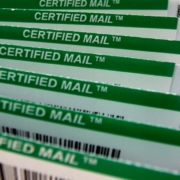How Direct Mail Performance Metrics Outpace All Digital Channels
The results are in, and they confirm what we’ve known all along. Despite living in an increasingly online world, direct mail performance metrics prove it is a competitive outreach option with some of the lowest prices and highest response rates of any marketing channel.
On the surface, this may appear counter-intuitive as more of us conduct business online every day. In fact, 300 million U.S. shoppers are expected to shop online in 2023—91% of the country’s population.
Logic tells us that buyers will respond to marketing communication on digital channels, too. Not so fast – direct mail marketing is outperforming all digital marketing methods. Let’s dig deeper.
Direct Mail Performance Metrics
The ANA/DMA Direct Mail Response Rate for 2018 indicates that when sending direct mail, house lists get a 9% response while a prospect list brings in an average of 4.9% responses. This is up from 2015 when the responses were 5.1% and 2.9% respectively.
This direct mail performance metric outpaces the response rates of email (1%), paid search (1%), social media (1%), and online display (.3%).
Five New Statistics You Need To Know About Direct Mail Marketing
 1 – Direct mail recipients purchase 28% more
1 – Direct mail recipients purchase 28% more
Individuals who receive direct mail purchase and spend 28% more than people who don’t receive the mail. And, because direct mail tends to be kept an average of 17 days, it’s there to remind the recipient of a product or service, igniting curiosity and prompting recipients to visit a website or store.
2 – Direct mail has an unbeatable open rate
Up to 90% of direct mail gets opened, compared to 20 – 30% for emails. This may be because we love our mail (59% of people say they enjoy getting mail about new products). And the average person fields hundreds of emails daily, so it’s difficult to stand out in an inbox.
3 – Strong returns
The overall ROI on direct mail was 29%, which matches social media response rates. Of course, another thing to be said for direct mail is that there is only one postal system. As social media continues to grow with new platforms, it’s going to steadily get more difficult -and more expensive- for businesses to find their audience on social networks.
4 – Less competition
In 2018, the USPS reports that direct mail is down nearly 29.8%. It’s good news for those of us utilizing it. Junk mail was infamous in the 90s-00s as everyone was using it, leading to respondent burnout and low return rates. With fewer fliers filling up mailboxes, it will be easier for direct mail to stand out, grab people’s attention, and continue to great direct mail performance metrics.
5 – Bigger OR smaller is better
In terms of form-factor, the worst-performing direct mail was the standard letter-sized envelope, which is presumably being overlooked in the mail shuffle. Those only received 3.5% response rates. Both oversized envelopes (5%) and postcards (4.25%) are a better value for the money, and more eye-catching.
Remember: Direct vs Digital Doesn’t Mean Either/Or
Despite the superior direct mail performance metrics, don’t think that means you must abandon digital operations. Many of the most successful campaigns -and all the most successful tracking- involve a combination of direct mail and online elements in a single campaign. You can have an online-friendly direct mail and receive the best of both worlds.
Want to know more about leveraging the power of direct mail? Just contact One Stop Mail with any questions about how to successfully use direct mail in the digital age.
Whether you need to generate new business or keep in touch with existing customers, you need to know the best ways to contact them – Download this free eBook and get the secrets to getting and keeping customers!














Leave a Reply
Want to join the discussion?Feel free to contribute!